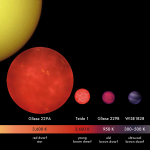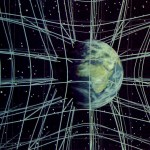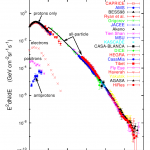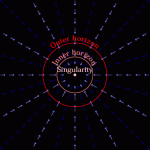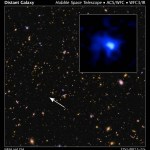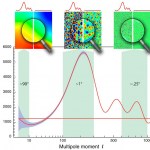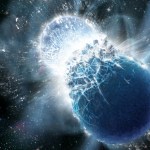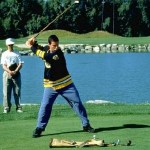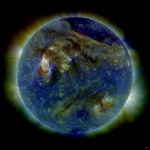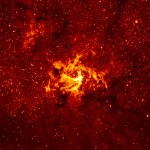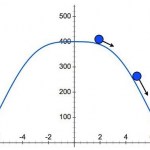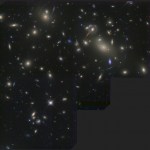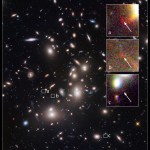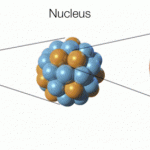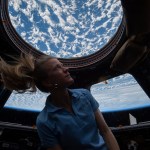
“Science knows no country, because knowledge belongs to humanity, and is the torch which illuminates the world.” -Louis Pasteur
Well, it's been another doozy of a week here on Starts With A Bang, and we've run the gamut from the far future to the smallest theoretical scales, from Hubble to the highest energies. If you missed anything, catch up on all of the following:
The last light in the Universe (for Ask Ethan),
Disney's Game of Thrones (for our Weekend Diversion),
The most extreme view into deep space (for Mostly Mute Monday),
The limit of what Hubble can see,…
“Never erase your past. It shapes who you are today and will help you to be the person you’ll be tomorrow.” -Ziad K. Abdelnour
But even moreso than the fact that we're shaped by our past, the Universe itself -- geometrically -- is shaped by its history and composition. You might imagine all sorts of possibilities for how the Universe could have been shaped: positively curved like a higher-dimensional sphere, negatively curved like a higher-dimensional saddle, folded back on itself like a donut/torus, or spatially flat on the largest scales, like a giant Cartesian grid.
Image credit:…
“Energy is liberated matter, matter is energy waiting to happen.” -Bill Bryson
When it comes to the Universe, you might think that energy really is only limited by rarity: get enough particles accelerated by enough supermassive, super-energetic sources, and it's only a matter of time (and flux) before you get one that reaches any arbitrary energy threshold. After all, we've got no shortage of, say, supermassive black holes at the hearts of active galaxies.
Image credit: NASA, ESA, Hubble Heritage (STScI/AURA).
And yes, we do find cosmic rays hundreds, thousands or even millions of…
“I just think too many nice things have happened in string theory for it to be all wrong. Humans do not understand it very well, but I just don’t believe there is a big cosmic conspiracy that created this incredible thing that has nothing to do with the real world.” -Ed Witten
So the cat is out of the bag, and has been for a long time: as far as theoretical physics ideas go, I think String Theory is a blind alley, a dead end, an idea for whom the fat lady has sung.
Image credit: Perimeter Institute’s Public Lecture series.
But all it takes is one prediction -- a prediction that's unique…
“No distance of place or lapse of time can lessen the friendship of those who are thoroughly persuaded of each other’s worth.” -Robert Southey
You might think that, when it comes to finding the most distant objects in the Universe, all we need is a good telescope, to leave the shutter open, and wait. As we accumulate more and more photons, we're bound to find the most distant, faint objects out there.
Image credit: NASA, ESA, R. Bouwens and G. Illingworth (UC, Santa Cruz).
It's a nice thought, but it misses an important fact: the Universe is expanding! And with that expansion, the…
“It is by going down into the abyss that we recover the treasures of life. Where you stumble, there lies your treasure.” –Joseph Campbell
Imagine you just stared into darkness, collecting every photon of light that came by. What would you wind up seeing? The Hubble Space Telescope has done this many times, creating the Hubble Deep Field first and then the Hubble Ultra Deep Field with upgraded cameras and more time. But most recently, the eXtreme Deep Field has surpassed even that.
Image credit: NASA, ESA, G. Illingworth, D. Magee, and P. Oesch (University of California, Santa Cruz), R.…
“When I was a kid, my world was five streets long. I never got away, except in books. I lived a thousand lives through books.” -George R.R. Martin
If you aren't enthralled by Game of Thrones (or for you bibliophiles, A Song of Fire and Ice), have I ever got an introduction for you. First, enjoy the Forte Tenors sing their tribute to the title theme of the show -- in high Valyrian -- along with a spectacular spectacle of a music video:
And then imagine this spectacular world... in the Walt Disney Universe!
Image credit: Fernando Mendonça, of Bran Stark with Hodor.
Quite…
“The heart can get really cold if all you've known is winter.” -Benjamin Alire Sáenz
If you didn't read everything this week on Starts With A Bang, it's hard to blame you. Each week, on practically a daily basis, we've got new pieces coming at you, sharing the wonders of the Universe in our own unique fashion. The past seven days alone saw the following:
Hubble vs. the Big Bang (for Ask Ethan),
The horrible conditions of s'more factory farms (for our Weekend Diversion),
NASA's greatest observatories view the galactic center (for Mostly Mute Monday),
What happens to…
“A single tiny light creates a space where darkness cannot exist. The light vanquishes the darkness. Try as it might, the darkness cannot conquer the light.” -Donald L. Hicks
While it might seem like there are an endless supply of stars in the Universe, the process that powers each and every one requires fuel to burn. At some point -- even though it's far in the future -- that fuel will all be spent, and all we'll be left with are stellar corpses of various types.
Image credit: E. Siegel.
But the Universe is full of second chances, and opportunities to bring not only burned-out stars back…
“What a shot by Happy Gilmore! <aside> Who the hell is Happy Gilmore?” -Announcer, from Happy Gilmore
After some intense physics earlier this week, it's time to get on to the important stuff: the physics of taking a running start and trying to beat the daylights out of a golf ball.
Image credit: Harold “Doc” Edgerton, of golfer Denny Shute in 1938.
Sure, it's the fun stuff that slapstick hollywood movies are made for, but does it actually work? The physics will inform you, but the practical results will amaze you!
Image credit: Universal Pictures, Frank Coraci, and Adam…
“Those who know that the consensus of many centuries has sanctioned the conception that the earth remains at rest in the middle of the heavens as its center, would, I reflected, regard it as an insane pronouncement if I made the opposite assertion that the earth moves.” -Nicolaus Copernicus
There are certain words that simply get people's hackles raised, shutting off the part of their brain that normally responds to reason and instead results in an emotional response taking over. For some, that word is "theory," one of the words with the biggest gap between its colloquial and scientific uses…
“Imagination will often carry us to worlds that never were. But without it we go nowhere.” -Carl Sagan
For thousands of years, humanity has looked up at the night sky and wondered at what might be out there. For the first time in all of our history, we not only have the answers to what's present in the Universe, we not only know the nature of most objects we see (and infer), but we even have images and true-to-life (we think) illustrations of them all.
Image credit: NASA, ESA and the Hubble Heritage Team (STScI/AURA)-ESA/Hubble Collaboration.
Wouldn't it be great if there were a book out…
Over at Starts With A Bang, Jillian Scudder of Astroquizzical takes on a doozy of a question:
If a photon of light escapes from a star, when it hits another star, does it get absorbed and have to complete another cycle before it can escape again?
After all, it takes (on average) over 100,000 years for a photon created in a star's core to find its way to the surface and exit.
Image credit: NASA/Jenny Mottar.
But what about the photons -- much lower energy than the gamma rays the core generates -- that hit the surface? Will they simply be absorbed and re-emitted outward, the way the Earth's…
“But I see it differently now. There has to be a middle. Without it, nothing can truly be whole. Because it is not just the space between, but also what holds everything together.” -Sarah Dessen
Sure, the Hubble Space Telescope gives us unparalleled views of our Universe. We can even use it -- with its near-infrared camera, NICMOS -- to view the very center of our galaxy, something completely blocked by dust in visible light.
Image credit: NASA, ESA, and Q.D. Wang (University of Massachusetts, Amherst), via http://hubblesite.org/newscenter/archive/releases/2009/02/image/b/.
But part of the…
“People speak sometimes about the “bestial” cruelty of man, but that is terribly unjust and offensive to beasts, no animal could ever be so cruel as a man, so artfully, so artistically cruel.” -Fyodor Dostoyevsky
Humans are part of the natural world, and yet although the natural world is hard and unforgiving in many ways, it's also abundant and generous. It all depends on your point of view and what your reaction to it is. Have a listen to Ben Harper's delightful, bittersweet tune,
Welcome to the Cruel World,
while you think about the upcoming summer, and the potential treats bound to ensue…
“The voyage of discovery is not in seeking new landscapes but in having new eyes.” -Marcel Proust
As another fine week comes to a close at Starts With A Bang, let's take a look back at all the topics we've taken on:
Where did light first come from? (for Ask Ethan),
Zooming into a fractal (for our Weekend Diversion),
Space turns green on 4/20 (for Mostly Mute Monday),
The illusion of reality (a great contribution from Brian Koberlein),
Everybody wants to rule the quantum world (a special extra from Paul Halpern),
Earth day in the Universe,
What is the strong…
“Silently, one by one, in the infinite meadows of heaven,
Blossomed the lovely stars, the forget-me-nots of the angels.” -Longfellow
The cosmic microwave background is a thing of beauty, as not only does its uniform, cold temperature reveal a hot, dense past that began with the hot Big Bang, but its fluctuations reveal a pattern of overdensities and underdensities in the very early stages of the Universe.
Image credit: NASA / WMAP science team, via http://map.gsfc.nasa.gov/mission/sgoals_parameters_spect.html.
It's fluctuations just like these that give rise to the stars, galaxies, groups…
When you think of the Hubble Space Telescope, perhaps you think of what's touted as its most major feat of all: peering off into deep, dark space, collecting light, and discovering the plethora of distant galaxies laying billions of light years beyond our own.
The Hubble Space Telescope’s Ultra Deep Field. Prior to the Fronier Fields program, this was the deepest look into the Universe available to human kind. Credit: NASA, ESA, H. Teplitz, M. Rafelski (IPAC/Caltech), A. Koekemoer (STScI), R. Windhorst (Arizona State University), and Z. Levay (STScI).
It's a spectacular sight and a…
“I found I could say things with color and shapes that I couldn’t say any other way — things I had no words for.” -Georgia O’Keeffe
We thought -- back in the time after Maxwell -- that if we understood gravitation and electromagnetism, we'd understand all the forces in the Universe. But once we started to dive inside the atom, and once we discovered the atomic nucleus, a new puzzle arose.
Image credit: Derek Owens, 2009.
You see, every atom other than hydrogen had multiple protons (and neutrons) inside of it. Yet if the protons had a positive electric charge and the neutrons had no…
“We came all this way to explore the Moon, and the most important thing is that we discovered the Earth.” -Bill Anders, Apollo 8, 1968
We've come an incredible distance in exploring the Universe. In the span of just a single human lifetime, we've gone from speculations about what other worlds in our Solar System might be like, the possibility of planets around other stars and wondering how many galaxies might be in our observable Universe to actual answers about all three of these profound questions.
Image credit: NASA / JPL-Caltech.
But as far as we've come, Earth is still the only…
